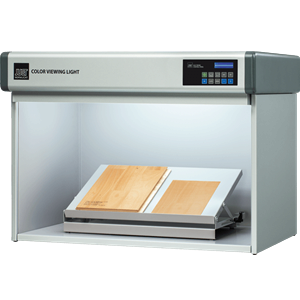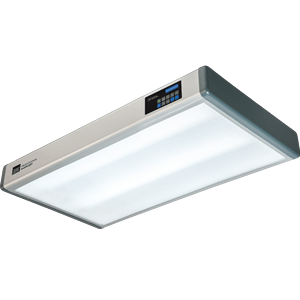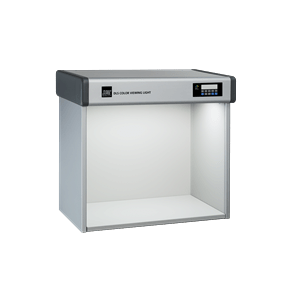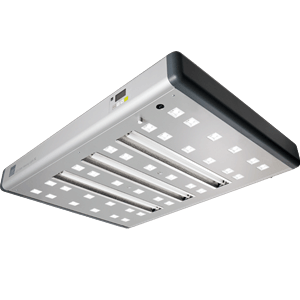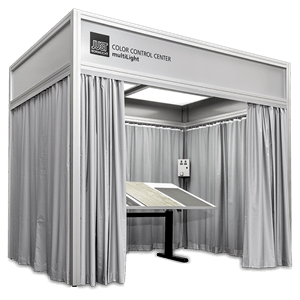Visual color assessment of different substrates
Be it in daily life or in manufacturing industries, in retail or in the private sector, many different light sources are in use today, such as sunlight, incandescent lamps, fluorescent lamps, energy-saving variants and, more recently, LED lamps. Each of these light sources has different spectral characteristics that strongly influence the human perception of color. If the same color is viewed under different illuminants, the color impression varies to different degrees.
This is referred to as color constancy. When two color samples look identical under one illuminant, but change under another illuminant, this is known as metamerism. This occurs when the two color samples were produced using methods that differ in one or more ways, including raw materials (e.g. inks/colorants and substrates), imaging methods (e.g. spray paint, wipe-on stains, direct inkjet printing), and finishes (air dry, UV cure, varnish or laminate overcoat, etc.).
Applications
To predict and avoid potential color matching issues in visual assessment of colored surfaces and materials, including paints, fabrics, ceramics, metals, plastics and paper, the use of color matching devices equipped with multiple illuminants is indispensable. Such devices are often employed in application areas such as:
- Research and development
- Product management
- Procurement & Supplier specifications
- Incoming goods inspection
- Manufacturing process control
- Quality assurance
- Technical, Sales and Customer support
The range of industries requiring precise color assessments for such applications is quite broad and often subject to international standards. Exemplary industries include:
- Automotive & Aerospace
- Biological & Pharmaceuticals
- Ceramics
- Chemicals
- Food and Agriculture
- Furniture
- Paints, coatings, finishes
- Paper and packaging
- Plastics
- Textiles & Fabrics
Multiple illuminants for metamerism assessment
To visualize the effects of metamerism, two products or color samples should be viewed and matched under different illuminants (at least three), ideally with identical viewing geometries and variables. The CIE illuminants D65 (average daylight from the northern sky), A (incandescent lamp), TL84/F11 (store lighting) and D50 (noon daylight) are very often used for this purpose.
Metamerism is efficiently simulated with a viewing booth or luminaire equipped with multiple, switchable light sources. Within a standardized viewing area, samples should be positioned closely alongside each other to support detection of slight color differences. Color changes due to optical brightening agents, security films and fluorescent products are more readily detected when the light source incorporates a switchable, additional UV-A source with a 365 nm peak wavelength.
Viewing devices with multiLight technology
You would like to see the complete product range? Visit our online shop »
LED solutions for simulating multiple illuminants
Increasingly, LED light sources are being used in general lighting, either as retrofits or in place of conventional light sources such as fluorescent, halogen or incandescent lamps. The challenge this presents is the spectral distribution of LEDs differs substantially from all other light sources and, as a result, the visual perception of colors viewed by them changes.
The accurate simulation of LED viewing conditions requires LEDs, and JUST offers multiple products incorporating LED technologies that simulates both other LEDs and the standard illuminants (e.g. A, D50, D65, etc.).
* Pat. No. US 8,592,748 B2
Ambient conditions for color assessment
Viewing conditions are the net, integrated result of a system that integrates all variables of both the equipment manufacturer and the end-use application. The end-use environment variables include light mounting and dispersion geometry, age and type of light source(s), surrounding areas, ambient lighting, and even the position and clothing of the personnel using the viewing area. When we measure this system we also have variables associated with the measurement instruments.
Ambient conditions, with respect to surround surfaces, have a major influence on color assessment. Consequently, the neutral-gray viewing area in viewing booths is also defined within the standards. JUST Normlicht viewing booths are generally coated in Munsell N7 – but they are also available in the neutral gray shades Munsell N5 and G5574 on request.
Standard illuminants
| Illuminant | Color temperature (CCT) | Definition | Application | Area of application |
|---|---|---|---|---|
| A | 2856 kelvin | Incandescent lighting | Home | Europe, USA |
| D50 | 5000 kelvin | CIE defined daylight | Color matching graphic arts | Europe, USA |
| D65 | 6500 kelvin | CIE defined northern daylight | Color matching manufacturing industry | Europe, USA |
| D75 | 7500 kelvin | Daylight | Color matching manufacturing industry in the US (not used anymore) | USA |
| F10 | 5000 kelvin | Fluorescent lamp similar to daylight | Offices, Showrooms, Exhibitions | USA |
| F11 | 4100 kelvin | Fluorescent lamp (formerly TL84 and U41) | Offices, Showrooms, Exhibitions | Europe |
| F12 | 3000 kelvin | Fluorescent lamp (formerly TL83 and U30) | Home | USA |
| F2 | 4150 kelvin | Fluorescent lamp (formerly CWF) | Offices, Showrooms, Exhibitions | USA |
| Horizon | 2300 kelvin | Fluorescent lamp (formerly WWF) | Simulation of dawn | USA |
| UV-A radiator | Fluorescent lamp (peak wavelength 365 nm | Detection of optical brighteners | Europe, USA |





